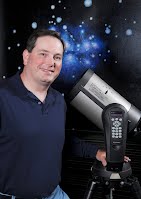Science on the Half Sphere’s first full-length planetarium show is Cosmic Castaways. In this series of posts, we will talk about how the show was made. The goal is to help other people interested in making full-dome planetarium shows see what we did, and hopefully avoid our mistakes!
 In the next series of postings, we will focus on Curt Spivey, our planetarium engineer, and the director of Cosmic Castaways. Curt has had a long and varied experience as a planetarium engineer and show producer. Take it away Curt!
In the next series of postings, we will focus on Curt Spivey, our planetarium engineer, and the director of Cosmic Castaways. Curt has had a long and varied experience as a planetarium engineer and show producer. Take it away Curt!
3. Your soundtrack is the backbone. My friend Alex Mak at the University of Toledo says it best: “You should be able to listen to and enjoy a soundtrack without a video.” Here is an area I didn’t know anything about before I started this project, but it is something I thoroughly enjoy, and I seem pretty good at. John told me the show became “real” for all of the collaborators when I put together the rough draft soundtrack.
Now, I am about to send you “down the rabbit hole” — Ron Proctor at Ott Planetarium put me onto the following FREE source for music: http://incompetech.com/music/royalty-free/ by the artist Kevin MacLeod.
You will spend HOURS there sifting and sorting what works for your show. Your music should reflect the mood of the show. I felt for Cosmic Castaways, we needed a lonely, melancholy feel. However, you must walk a fine line – don’t make the music so innocuous you put your audience to sleep, but you also don’t want them guffawing over some super-dramatic music at the wrong place. It is also important not to let your personal taste ruin your soundtrack. I personally have diverse and eclectic musical tastes, from classical to jazz to punk to electronic, but somehow I don’t think The Clash would work in a planetarium show! (Well, maybe someday….)
4. Don’t reinvent the wheel. There are TONS of great computer simulations and astrophotos out there for just about ANY astronomical phenomena. One of our collaborators, Chris Mihos, was one of the first to simulate galactic interactions, and we made good use of his work in our show. John, Pat and Chris had also worked with Frank Summers, who created that fantastic sequence that alternates between Hubble images and computer simulations. I actually saw that before we wrote the script and I knew it had to be part of the show. NASA is a great source – your tax dollars already paid for this stuff, so it’s FREE! Just make sure to get the proper permissions and give proper due in the credits.
In the final post of this series, Curt will give some assorted tips for anyone making their own planetarium shows.
No comments yet.